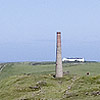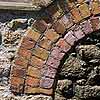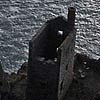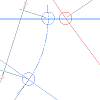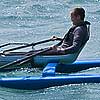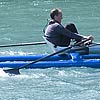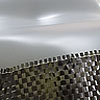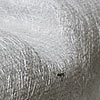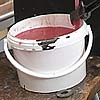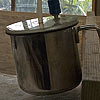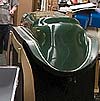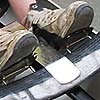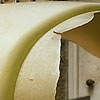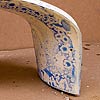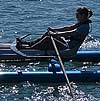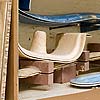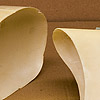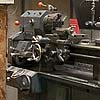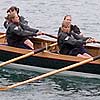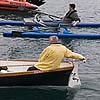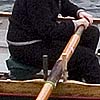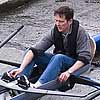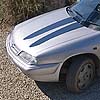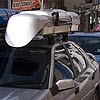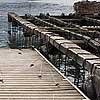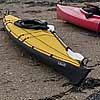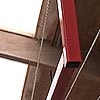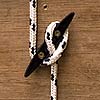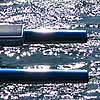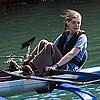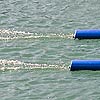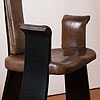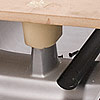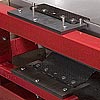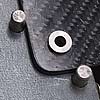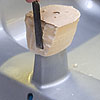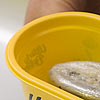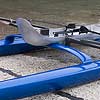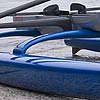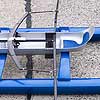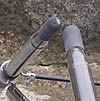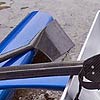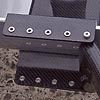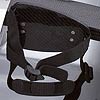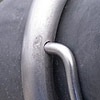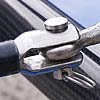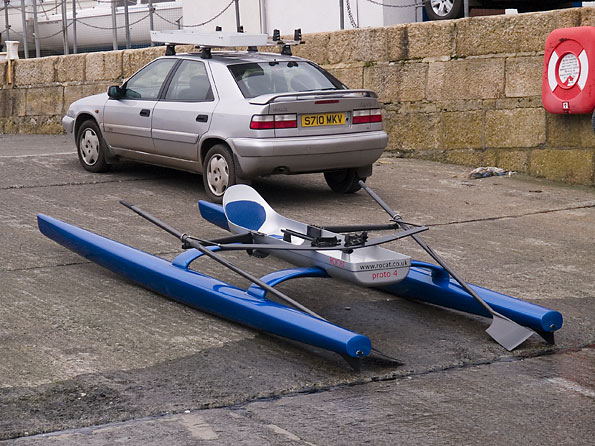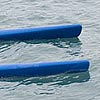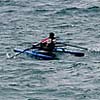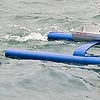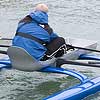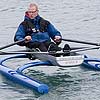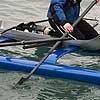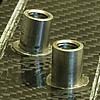|
archives
|
||||||||||||||||||||||||||||||||||||||||||||||||||||||||
| 2006 - first half | ||||||||||||||||||||||||||||||||||||||||||||||||||||||||
|
30 May 2006 It was a 'bank holiday' yesterday and, as the weather was uncharacteristically beautiful (for a bank holiday), we gravitated once again to the coastal path. The bleak western tip of England is steeped in so much interesting history. The remains of ancient dwellings abound on the moors, and you can't go far without seeing relics of its tin mining past. From my office I can see Ding Dong mine which, according to some, dates back thousands of years; and the gaunt ruins of mine engine houses are very much part of the Cornish landscape, especially on our north coast. The first ever steam engines were used to pump water from Cornish tin mines, and these are the buildings which housed the huge beam engines. Mine workings went for miles underground, and some beneath the Botallack Crown mines went up to 3 miles out under the sea. The miners worked a 10-hour shift and were only paid while at the face – not only did they have a rough 3 mile walk by candle light each way, but they also had to climb down and up some 1,000 or so feet of ladders as well. Some mines had 'man engines' to lower the men to their working levels and bring them back up. Once the ore was raised from below, it was all carried by pack animals some 18 miles east along the coast to Hayle to be smelted. That brief Cornish history lesson is by way of a break from the usual topic in keeping with the holiday! I have lent proto 4 to Richard Bland (from Composites Integration) for some thorough testing by himself and a number of experienced fixed and sliding seat rowers – I will report on their reactions in due course ... CL ... 1) Levant mine – famous for the loss of 31 men and boys when the man engine broke, and they all fell down the shaft to their deaths; 2) a ruin of an engine house; 3) Botallack Crown mines at the base of the cliff; 4) the coastal path along which pack animals transported the tin ore. |
||||||||||||||||||||||||||||||||||||||||||||||||||||||||
|
23 May 2006 In an effort to try and understand the 'gearing' question better, I decided to draw the power stroke (catch to perpendicular) for a regular sculling boat and the ROCAT. Jake felt that the ROCAT stroke was considerably shorter than his coastal scull but, on measuring the two strokes, there was only 50mm in it. On his return to Southampton, Jake sent an analysis of his ROCAT row. Following a detailed critique of the ROCAT stroke he said, Have a look at the drawing to see how high the gearing is for the ROCAT power stroke – it's a .pdf, so I hope you can open it OK. I really must get some blog or forum software going, because this would make a good discussion. But, meanwhile, please email your observations ... CL ... a drawing of the power strokes of a regular sculling boat and the ROCAT |
||||||||||||||||||||||||||||||||||||||||||||||||||||||||
|
21 May 2006 The seatdeck moulding cycle has gone very smoothly, and we have three seatdecks trimmed and ready for paint. Jake Frith came down from Southampton yesterday to try the boat. Jake, who is an experienced coastal sculler, has been following the ROCAT's progress since he saw the boat on the 'Concept Boat' stand at the 2003 London Boat Show. Hearing that we planned to take the ROCAT over to the 'British Coastal Challenge' in Guernsey in September, he tentatively volunteered to row it for us. Fortunately for the trial, the rain had passed over and the sun shone. There was a brisk 30mph breeze however, but it was offshore so he didn't get to experience how the boat handles a big sea. When he came in he told me that he liked the boat, but didn't think that it would do very well in Guernsey the way it is – I can't deny that this came as quite a blow. With Anthony's help, I believe I have produced the only fast rowing boat that can be safely, and enjoyably, rowed on a very rough sea – is it very greedy of me to want it to be able to beat other open-water boats on speed too? Richard (boat #2) has cautioned me to moderate my expectations, speedwise, but I reason thus: So far as I could work out when I designed the hulls in the first place, the ROCAT has a little more (perhaps 3-5%) 'wetted surface drag' than a sculling boat; but its extremely slim hulls have practically no 'wave-making drag', and the hullform is very clean and hydrodynamically sound. On top of that, the rig is more powerful – because you have a solid back to push against, you can exert more force on the footbar which is transmitted directly to the oar, (which can be easily demonstrated with a leg press in a gym, or a recumbent bicycle). So with the overall hydrodynamic drag being similar, perhaps a little more, but the rig being more powerful, it seems reasonable to suppose that there would not be a lot of difference in speed. A number of things that Jake suggested derive from a sculler's mindset, and were either not possible or, because they would require new main moulds, not practical on grounds of cost. However, his first observation that the rig is too high geared does ring true, and is easy to remedy. There are any number of rigging charts for sculls, but none for a ROCAT rig, which is quite different. It's going to be higher geared than a conventional rig because you can push harder with your back supported (just as a more powerful engine can pull a higher gear in a car), but how much higher? – it would appear that I have gone too far. We will set up one of the new Dreher oars with less outboard (inboard is fixed) and see if it's better. Although ROCATs racing ROCATs will happen in due course when there are enough to make a race, it would be good if ROCATs could also be competitive with the best open-water boats around. The trouble is, the races in which it would leave the competition standing, when it's blowing force 5 or 6, will be cancelled as unsafe for monohulls! ... CL ... 1) three seatdecks; 2&3) the coastal sculler tries the ROCAT in a stiff breeze. |
||||||||||||||||||||||||||||||||||||||||||||||||||||||||
|
12 May 2006 A lot of the visitors to this website come to read about the technology we use in producing the ROCAT so, for this post, I crave the indulgence of the rowers while I go through the production of a seatdeck. Because we are not using gelcoat, we have found that spraying epoxy primer into the mould works well, and we can spray it on to the Frecote 770 semi-permanent release agent without problems. We use Saercore glass to reinforce the seatdeck, with some additional carbon around the back of the seat. Saercore (which is similar Rovicore) comprises random strands of glass either side of a 'resin infusion medium'. It's an excellent product which is largely responsible for the seatdeck being the easiest, and most reliable mould. We use a preform tool (a rough copy of the mould) to shape the Saercore, which is extremely good at conforming to quite complex double curvature shapes. The seatdeck mould is a 'matched mould' which has a 2.5mm cavity between the top and bottom mould surfaces. Once the layup is complete, the top is eased on and the vacuum clamp applied to hold it all very tightly together. The epoxy resin is mixed and degassed to remove the air that is introduced during the mixing process. For this mould we use a 40% vacuum in the mould cavity to draw the resin into the dry reinforcement. Due to the complexity of the shape, we use two vac ports; these have catch pots to eliminate the risk of resin being pulled into the vacuum pump. When we have resin showing at both the vac ports, we clamp off the resin feed; back off the cavity vacuum; take the vac port tubes out of the catch pots and 'head' them – raise them up with resin in to ensure no air gets into the part. The seatdeck is then left to cure overnight. We are coming to the conclusion that, with the present space and limited staff, it makes most sense to produce the boats in batches of three. So we have made the seatdecks for boats 1 and 2, and will produce 3's next Monday. A number of people who have tried the ROCAT have observed a tendency to slip down in the seat – I am slightly bemused by the fact that I never feel that, but it was something we had to tackle. So we set up proto 4's seatdeck in the workshop to get Anthony to identify what's happening so we can devise a remedy. We also used the opportunity to test the strength of the rowlocks under a static load (which is far more than one can apply with oars). The rowlocks checked out fine, and we found that some additional padding at the front of the seat seems to cure the slipping down problem. We also chopped up proto 3's seatdeck in order to establish if the rake of the seat back was the cause – very fortunately, Anthony decided that the present rake is good. proto 4 is back in action, and I aim to do another longish row this weekend ... CL ... 1 & 2) laying up the seatdeck with carbon and Saercore; 3) infusing the resin – we tint it to make it easier to see in the translucent plastic tube; 4) the resin showing to indicate that the cavity is full; the catchpot is on the right; 5) 'we have a good part' – we are still so new to this that it's great when it happens! 6) testing the seatdeck and rowlocks in the workshop 7 May 2006 The web hosting move went remarkably smoothly, much to everybody's relief – I have heard tales of domains getting lost in cyberspace for days. So far, then, I'm well pleased with 'clook.net' – their customer service/support seems excellent. We have just taken delivery of the 'stiff' oar shafts from Dreher and what a difference! They look and feel really good, and I reckon we need have no further concerns about breakages with them. They are quite oval in cross section, with additional unidirectional carbon on the leading and trailing edges, where it's needed. We also ordered a pair of their rounded 'Apex R' blades to evaluate – they look quite strange, but are beautifully made (as we've come to expect from Dreher), and we are looking forward to trying them. I have been asked how we make the foam polyurethane blanks which we use in all our carbon fibre parts – I described it ages ago, so it's in the archive, but I thought I'd just recap. The normal way to make shapes with PU foam is to mix the two components, pour the mixture into a mould, and close the lid. We tried that, but the quality of the foam was awful. Then, quite by accident, we discovered that the quality of the foam is greatly improved if it foams outside the mould, and is forced into the mould through small pipes. It's very low-tech, but produces clean foam of very even consistency. Interestingly, the foam that erupts from the vents is even better quality, but we can't work out how to achieve that – nor can we get a good explanation of why that's the case. I love strange phenomena! Anthony had cast a crossbeam blank, and it was sitting on the hull mould when he resprayed the hulls. When he'd finished, he noticed that the overspray had settled on the crossbeam blank in the most extraordinary patterns. Must be static, but why on earth did the dust settle in those shapes? ... CL ... 1) preparing the crossbeam foam mould; 2) after it's foamed: 3-5) the stage patterns on a crossbeam foam blank after Anthony resprayed the hulls; 6) after some work in Photoshop, this one could hang in a gallery! 5 May 2006 The ROCAT website is moving from 'NetPivotal' to 'clook' – I hope the transfer will be smooth! ... CL 30 April 2006 As regular visitors will know, we make all the carbon fibre components inside closed moulds, using a core of cast polyurethane foam. We were so pleased when we managed to find a low-tech, but very effective way of making these foam blanks and, with practice, Anthony is producing good foam. But the other day, we noticed that a bubble was appearing on the surface of David's footbar after it had been heated for post-curing. We eventually worked out that, although the foam looked good on the outside, it contained pockets of air – one of these had expanded with the heat, and distorted the softened epoxy resin. Until we can find out how to eliminate these voids, we are fortunately able to see them by shining a bright light through the foam, so we can spot, and fill them. In order to improve the consistency of the foam blanks, Anthony has built a warm cupboard for the foam moulds to keep them at a constant temperature. Having developed the boat, we are now having to spend too much of our time developing the manufacturing processes. Talking of foam, we have added 'hull end plugs' to the list of foam parts – these will make the hulls easier to lay up, remove the need for the bag to push into very tight corners, and also make the hull extremities considerably stronger. We will soon be installing heating on the hull and crossbeam moulds to post-cure these parts – post-curing makes the resin tougher and raises its temperature tolerance. For all that the ROCAT is a very 'high-tech' craft, which pushes advanced composite technology, until the manufacturing volume goes up considerably, making the boat is a labour-intensive 'handmade' process. We have finally got around to installing the old (but good) Boxford VSL lathe – with it we will be able to produce a number of small turned parts that we need in quantities too small to be worth farming out ... CL ... 1) another shot of the ROCAT in the harbour; 2) the foam mould warm cupboard; 3) the foam hull end plugs, and 4) the Boxford lathe. 23 April 2006 I have put up a couple of new videos which you can find here . We decided to respray the hulls a) to get rid of the scratches and b) to test the Basler Lacke clear finish over coloured base coat. We were very impressed how tough it was when applied to the naked carbon fibre on the footbar ... CL 18 April 2006 If Ned Beck reads this, please email us, as our emails to you are bouncing ... CL 16 April 2006 Cornish Pilot Gigs have a long and noble history, and the story of their recent revival for racing is a fascinating one – look here and here for some gig gen. But they are not unique; there are equivalent boats elsewhere which are all part of a dramatic increase in interest, over the last few years, in open-water rowing of all kinds. And, in parallel with the revival of traditional craft, more modern sliding seat boats are also becoming increasingly popular, especially in Europe and north America – what a good time for the ROCAT to be born! Generally called 'open-water rowing' in north America, and 'coastal rowing' in Europe, this year sees the birth of two new 'national championships'. Over in Settle WA, Maas boats are sponsoring the first United States Open Water National Championships at the end of August. This event, which will be hosted by the Sound Rowers, will adopt the 7.6 mile 'Great Cross Sound Race'. Then, at the beginning of September, The Guernsey Rowing Club (in the Channel Islands), will be hosting the first British Coastal Championship. This event looks like it's going to be a lot of fun, and we plan to be there – if they will let us race, and we can find a really good couple of rowers to take part in the ladies and men's races, we could do well – especially if it's rough! On the following day, the GRC will host the World Coastal Championships. These races will be under FISA's rules so, as the ROCAT does not conform, we will have to give them a miss, although I completely fail to see why their ban on moving riggers should apply to coastal rowing. I believe strongly that the sport of open-water rowing should be inclusive, and that it should encourage diversity and innovation. Such rules as there are should concentrate on ensuring the safety of the rowers, and not on the arbitrary regulation of a boat's configuration. The ROCAT is probably safer than any existing open-water rowing boat, but it is excluded from FISA races – is that not a mite perverse? Unfortunately, I fear that open-water or coastal rowing will become split between the open-minded attitude that is to be found in Puget Sound and, hopefully, the British championships, and the exclusive regulation-bound attitude to be found in the FISA offices. If I am wrong in this analysis, I would be very happy to be put straight. We had Stephen and Richard down from Composite Integration 1) to help us get rid of the tiny voids we are still getting on the surface of the naked carbon fibre parts, and 2) try the boat. We modified the footbar and car to gain a bit extra stroke length to accommodate Anthony's long legs, but Stephen's legs are longer, and the track is not long enough for him! Hmm, and I designed it to fit the 99 percentile man, too. I was interested to hear that Richard had spent many years gig-racing at the highest level, and is a very experienced rower – so his complimentary remarks were very encouraging. I was also interested to see how he adapted instantly to the ROCAT stroke. Decided to go for that longish row yesterday, and went back over to the Fal estuary. Mylor is an excellent place to put in – £2 for parking all day, and a good wide concrete slip that works at any state of the tide. West Cornwall has big tides, BTW, with up to 7.6m between low and high. Being unused to gps, I was bemused to find that, although rowing quite hard, I was making poor headway. Then I realised that I was rowing upstream and against an ebb tide – when I turned around, I flew! The mirrors that I had attached (black blobs at the back of the seatdeck in the 2nd from last pic) were hopeless – too low, so the rigger got it the way. But, manoeuvring out through the moored boats, I was doubly convinced of the need for good mirrors. They will be on stalks next time. Arriving back at the slip, the gps showed 9.3 miles – a good outing ... CL ... 1, 2 and 3) are of the Penzance-based gigs; 4 and 5) show Stephen and Richard, who was going very well at the time; 6 and 7) are of the boat on the car roof; 8) the boat is tied up to a strange contraption, which I believe is related to the famous Fal oyster fishery; and 9) is on the foreshore beside the Pandora Inn, where I stopped for some sustenance. Unfortunately, the sharp stones in the squidgy mud scratched Anthony's beautiful paintwork – since he painted those hulls, we have found an extremely tough top lacquer which we plan to use henceforth. 12 April 2006 We've just about finished getting the manufacturing infrastructure in place – as usual, it took longer than expected, but it will save a lot of time in the long run. We now have three boat's worth of hull jig frames constructed and slung from the roof on a cat's cradle of ropes and pulleys – these frames will be central to the hull production workflow. Soon after the hull comes out of the mould, the holes are cut for the sockets; the moulding bag is removed, and the buoyancy bags inserted. Then the frames are used to bond the sockets into the hulls in perfect alignment. Their next job is to support the hulls firmly whilst they are being painted – this way it's possible to paint the whole hull in one go without the support showing on the painted surface. Then the hulls are stored on the frames for a week while the paint sets hard. We went out again last week on a beautiful spring day. Adam Woolfitt shot some video, which I'll post in the gallery soon. I'd got a mount for the eXplorist GPS (which attaches conveniently on to the front track post) and enjoyed being able to see the boat's speed and direction with ease. I hope to do a longish trip over the Easter holiday but, based on what was showing on that excursion, 5+mph is a comfortable ambling pace. Pushing harder, I maxed out at 7.8mph which, considering my lamentable lack of fitness, was quite satisfactory – I would love to get a very strong accomplished athlete on board (doesn't need to be a rower) a) to see how fast it goes, and b) to see what he or she could break! Anyone within reach of Penzance, who answers that description, would be most welcome to come and have a go. Picture 5, BTW, was taken when I was doing about 7mph – interesting to see the complete lack of bow wave. The shape and fit of the seat has come under a lot of discussion recently. In a previous existence, I spent a number of years designing, and making, fine modern furniture. I found chairs the most satisfying to make because they had to interact with the user, and be comfortable. When I came to design the ROCAT seat, I assumed I would simply be able to apply my chair design experience – apparently not so! Although I have absolutely no problem myself, and find the seat very comfortable, some users have said they find themselves slipping down the seat as they row. Of course, given the tremendous range in the size and shape of humans, it's not too surprising when one size doesn't fit all, but the chair in picture 6 very nearly did. We are getting some sheet Zotefoam, and will experiment with ways to modify the seat's shape to fit different statures. In kayaks, manufacturers supply their customers with a block of foam for them to whittle away until it fits. Easier that way than building numerous different sized seatdecks ... CL ... the top picture shows the hull jig frames suspended from the workshop ceiling; the next picture is of half of the rope tails; Then three pictures of the ROCAT in action in the harbour; followed by a picture of a chair I made for a exhibition in 1977 – subsequently, I used it as my office chair for years. 2 April 2006 Although we have started making the boats, development continues. When I fixed the yoke into proto 4's seatdeck, the precise alignment I had to do it by hand and it took hours to align of the top and bottom swingarm brackets 'by hand' took hours – clearly, a jig was urgently needed that would automatically set everything up 'spot on' while it's bonded into place. Anthony has now built this contraption, and it will quickly save us the time it has taken to make. For the jig to work, the seatdeck's location in the jig must be precise, and part of this location is provided by a cunning socket which fits on to the rear track post. Casting resin was used for this, and the post 'released' in the normal way. Unfortunately, when we came to demould it, we couldn't, so we had to make it again, using cling film this time – thank you Utterly Butterly for the perfect mould! The holes in the plates were laser-cut by LaserMaster in St Day – I wanted to compare laser cutting with waterjet cutting – both are remarkable technologies. Quite early on, when we made the decision to paint the ROCAT, rather than use coloured gelcoat, metallic paint was always part of the deal – it does take longer than a plain colour but, because it can look so good, we reckoned it was worth it. That's crazy, I was told, nobody paints rowing boats in metallic paint – so far they don't, but I wonder how long before others follow suit?! One problem we've had, though – it turns out the the relatively poor results we got with the silver seatdeck were not down to inexperience. Consulting the experts, we find that it is the most difficult 'colour' to get right – it apparently needs twice as must preparation because it seems to highlight, rather than cover, the tiny scratches that are part and parcel of 'rubbing down'. In due course, when we have a dedicated spray facility, we will probably offer silver as an optional extra, along with other spectacular custom 'candy' finishes but, for the time being, I'm afraid silver has to be off – that just leaves some 60,000 other colours to choose from! Also, we are coming around to thinking that if the boat has metallic hulls and crossbeams, it will probably look better with a non-metallic seatdeck – you can have too much of a good thing ... CL ... three pictures of the new yoke and bottom bracket mounting jig, followed by a picture of the 'stuck' location socket and the mould for its replacement. 28 March 2006 Huh! How we depend on our computers! The 'programs' hard drive died on my machine. I had bought a pair of 45GB IBM/Hitachi drives a while back and these both failed within weeks of each other. Eventually, Hitachi replaced the dead drives under warranty with two 'refurbished' units – this drive was one of those! While I didn't lose any data, it seems to take forever to get the parts, load all the applications, and the drivers, and all those configurations and workarounds applied over time that get the machine running smoothly the way one wants it – one day, ROCAT's IT department will handle all that, but till then, it's down to me! We had hoped to be able to get out testing last week, but we have had the worst weather of the winter so far. While I have been working on the computer and ordering materials etc., Anthony has been making jigs and foam blanks and generally getting all the moulds ready for production ... CL 18 March 2006 Went out this morning. It was rRUFF – the sort of nasty choppy rough that comes from a bitter 30mph east wind over a 5 mile fetch; the temperature was 2°C too and, with frozen hands, I called it a day after half and hour (wimp that I am – we are not used to these conditions in temperate Cornwall). I have really enjoyed being out in big ocean, near-gale (storm elsewhere) rough, but there was no pleasure in this. All part of the testing process, though! Recently bought a Magellan eXplorist gps, which I fitted for the first time. One of the most common questions I get asked about the ROCAT is 'how fast is it?' – I got this to find out, and also to log how far we go testing proto 4. Bearing in mind that I am very unfit, and have to learn how to use the thing, 5mph seemed a comfortable sort of cruising pace in the sheltered harbour. When the weather improves, I will take it out for longer, and report. We have just had the 'terms and conditions of sale' translated into Spanish and French by Atlantic Translations in Plymouth – very happy with their excellent service ... CL 17 March 2006 Here are some more pictures of proto 4, and details thereof: ... pictures 1-4 shows the boat on the Penzance slipway. The keels are protected by very tough rubbing strips. 5 is a rower's eye view of the seatdeck; 27 February 2006 – WE'VE MADE IT – well almost! The development of the ROCAT has had it's full share of ups and downs, and yesterday it provided a good dose of both! On a decidedly chilly, overcast Sunday afternoon, a small group huddled around as we assembled proto 4 (the full production prototype), and I took it out for the first time. The culmination of six years' hard-fought development, I was apprehensive and happy! Pausing every so often to catch my breath – dammit, I'm unfit – heightened senses were taking in every aspect of the boat's behaviour. Made it, at last, I thought! Penzance has been such a good place to develop the ROCAT – it has a good slipway and an excellent sheltered harbour. Then, just around the corner, and you can enjoy the ocean in all its many guises – yesterday it was choppy enough to feel the motion, and that felt good too. Well content, I came back in for Anthony and Freya to have a go. Anthony, who had thoughtfully come colour-coordinated, stuck to the harbour and, after gaining some confidence toing and froing in the new boat, began to push it harder. Part of his job is to test the boat to destruction and, on this occasion, he managed to break an oar! I hasten to say that I don't blame the oar for this – I chose to supply Dreher oars with the ROCAT because, from my research, they are the best available, with a blade shape that I like. The trouble is, although I know the ROCAT rig is powerful, I underestimated the load it puts on the oar, and overestimated the oar's strength. I know it's very unscientific, but when I'm trying to work out what will break, I sit the likes of Ed Coode in the boat, and try to imagine how the boat would fair. As we didn't make the oars, I had no feeling for their limits. This breakage is a nuisance, but not a serious problem – we will reinforce the oars where they go through the rowlocks and it won't happen again ... I have since talked through the problem with Durham Boats (who make Dreher oars), and they reckon that the different construction of their stiffer shafts would be better suited to the ROCAT's rig, so we will change to those. More of a problem, though, is the thick carbon 'car' which suffered collateral damage. Anthony was in the middle of the power stroke when the oar broke – suddenly, all that force was hitting one side of the rig, instead of being balanced equally between both sides. This twisted the car enough to let a front wheel jump the track, and bend its axle mount. While this was, undoubtedly, an exceptional load, I am concerned that it could have done that, so Anthony and I thrashed out a replacement car which will be much stiffer in torsion – just when we thought we'd finished that phase! Meanwhile, I think we have decided what to do about the one-design thing, and will cover that next time. Also, apart from the car, which we can fix, I am satisfied that we can now produce the boat that I had in mind when I set out on this long journey, so I will soon begin to take orders for the ROCAT – must just finalise price and 'terms and conditions of sale' ... CL ... proto 4 on Penzance slip; 3 pictures of me rowing, followed by 2 of Anthony; the skilled kayaker tries padling a different kind of boat; the damaged car. 1 January 2006 And a Happy New Year! What does 2006 hold for the ROCAT? Its lengthy gestation period is nearly over. This is not the story of a corporation, and the well-funded development of another new product; it's about one guy who, having identified a massive hole in the market, has spent the last six years working full time to design and develop his idea, and bring it to market. But I could not have got this far without the generous backing of 'friends and family' or, latterly, the very capable assistance of Anthony (ROCAT's first employee). But most of all, I'm indebted (along with everyone who subsequently enjoys the fruits of these labours) to Alison, my incredibly supportive publisher wife (www.alison-hodge.co.uk) – to all the above, I offer my heart-felt thanks. A strong vision of the ROCAT's ultimate success sustained me through the (often difficult) development years. When we finish this first production prototype, I am content that we will have the product I was looking for back in 1975, when I first came up with the idea. It will be a high quality rowing boat which provides an unparalleled combination of speed, stability and transportability. I know that it works extremely well and believe it doesn't look too bad, either – it remains to be seen how many people will agree with me when we open the order book, and begin to make the boat ... after all this time, that prospect is both exciting and scary! ... CL | ||||||||||||||||||||||||||||||||||||||||||||||||||||||||
